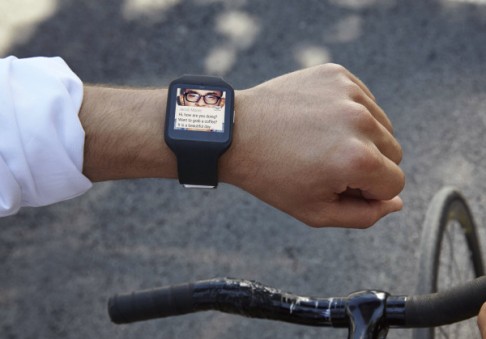
Apple Watch vs. Android Wear - will smartwatches catch on?
On the eve of the release of the Apple Watch, we compare it with some of its competitors
- isn't that the one that only comes in gold and costs HK$130,000? When Apple announced its latest device in March after months of speculation, it was careful to mention a special custom 18-carat gold alloy Apple Watch Edition. The gadget since has grabbed headlines both good and bad (OK, mostly the latter), and has helped insert into everyday conversation the idea of a smartwatch as "trophy tech".

Luckily for most of us, the price for the "normal" Apple Watch is far lower - it starts at HK$2,728. The positioning of the Apple Watch as a luxury status symbol does beg the question: does anybody actually need, or even want, a smartwatch? Available to pre-order in Hong Kong on April 10 ahead of availability on April 24, Apple Watch comes a full decade after many people abandoned their wristwatch to rely only on a smartphone as a timepiece. But smartwatches are not about telling time. Linked to a phone via Bluetooth, they're about controlling a phone hands-free. On a smartwatch, new emails, messages and texts can be seen at a glance, music can be controlled, and apps like a compass, activity tracking and weather data are all made wrist-ready.
The smartwatches that are hitting store shelves are the first salvo in a battle to replace the pocket phone.

"We expect sales in wearables to go up by 38 per cent in 2015," says Annette Zimmermann, research director at analyst firm Gartner, which has offices in Hong Kong. For now, the smartwatch and the smartphone will co-exist. "We don't see these devices replacing the smartphone in the next five years, rather they are a complementary device," she says, but adds that the latest high-profile smartwatch should help popularise the concept of wearable devices.
"Apple Watch is bound to trigger more awareness for wearables, and Samsung, Sony, Lenovo and others will have to come up with more attractive products to compete," she says.

All Android Wear smartwatches have common apps provided by Google, such as Wear Fitness Personal Trainer, which has been growing fast since launching in October. However, all Android Wear watches have something extra, or a design quirk or two, to differentiate them.

Upcoming Android Wear to watch out for later this year includes the fitness-orientated Lenovo Vibe Band VB10 (which has an e-ink screen and a step-counter), the fashion-conscious LG Watch Urbane (which includes a SIM card) and the sapphire glass-fronted Huawei Watch (which adds a heart rate monitor).
There's a third party in the usual Apple vs Android battle, however. One of the most successful smartwatches to date has come from a small US-based boutique brand called Pebble. Its first product used an e-paper screen that stretched the battery to seven days (battery life is a big problem for most smartwatches, which tend to need recharging every day), but its upcoming Pebble Time Steel will tick for an impressive 10 days on a single charge. It is equipped with a colour e-paper screen, and various straps will be available that come embedded with a heart rate monitor or GPS sensor. That's an easy way of customising a smartwatch, and ought to catch on.
Despite the influx of smartwatches focused on fitness, traditional watchmakers haven't been able to resist joining in. Swiss watchmaker Breitling's upcoming B55 Connected watch can link to a phone via Bluetooth and, with an automated time-zone adjusting feature, is aimed at frequent travellers.

MotionX is also being added by watchmakers; a sensor counts your steps each day, something most smartphones can already do. Tag Heuer has also revealed its intention to produce a luxury watch by the end of 2015 based on Android Wear.
The smartwatch is beginning to look inevitable, but for now, the focus is on Apple Watch and how it performs in China. For the first time since the product's launch, iPhone sales in China were bigger than in the US in late 2014, and the appetite for wearables in China is thought to be bigger than anywhere else.
Will it catch on? With active Hongkongers, it could prove irresistible; fitness is undoubtedly the "killer app". Elsewhere, the smartwatch is just a status symbol, and not much about productivity. Many won't want yet another device that needs a daily recharge. But it's early days for smartwatches, and in the coming months and years the apps available on Apple Watch and others will eventually reduce everything a phone can already do to a flick of the wrist. It's possible the smartwatch will eventually replace the mobile phone. Just give it time.
So, what is it the Apple Watch can do?
Apple's latest product is about fitness, with a heart rate monitor and an app that tracks your movement and lets you know how long you've been sedentary. It's also about convenience; you can conduct hands-free calls, make digital payments using the Apple Pay app, and board a plane using a boarding pass in the Passbook app. It displays calendar events and sunrise/sunset times, and you can also ask Siri for directions. A gentle tap on your wrist means a notification or message has arrived, and you can even message someone a tap (or even your own heartbeat), but you will have to dictate messages - there is no keyboard on the watch's touch screen.
Apple Watch comes in two sizes (38mm and 42mm) and two mainstream versions, with strengthened Ion-X glass on the lightweight Watch Sports (from HK$2,728) and sapphire glass on the Watch (from HK$4,288).

